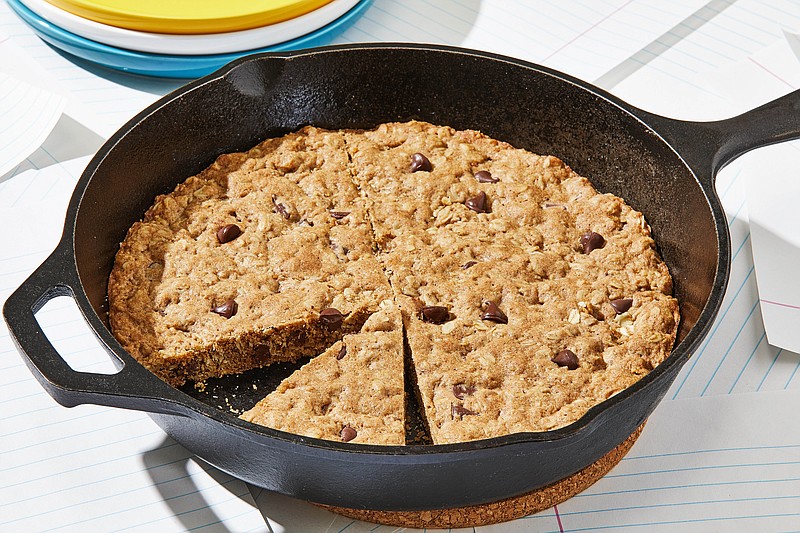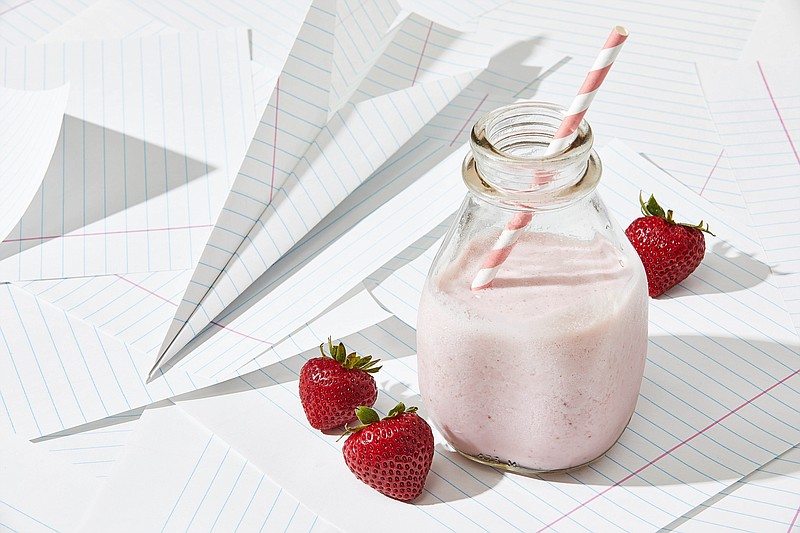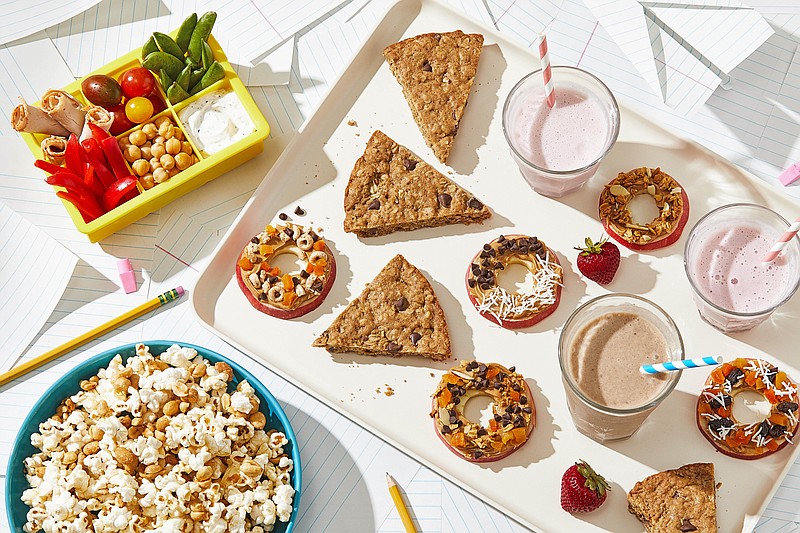The new school year not only means a new routine for kids, it's also an organizational shift for adults — an opportunity to rethink ingrained habits and foster more healthful ones.
And snacks are a great place to start. School-age children get about a third of their daily calories from snacks, making between-meal eating as important for nourishment as breakfast, lunch or dinner. With these strategies and snack recipes, you'll have ample tools to put yourself and the kids in your life on the best possible track.
◼️ Take a wide-angle view. An all-or-nothing approach to eating is a trap at any age, but it can really backfire when it comes to getting kids to eat well. Highly restrictive approaches and pressure typically glorify the forbidden. The helpful reality is that a healthful diet has a lot of flexibility: If you are mostly eating minimally processed foods, including plenty of vegetables and fruits, a bag of chips or gummy worms now and then, or a cookie isn't going to wreck the day. Rather than stress over one snack or ingredient, present an array of healthful ones.
◼️ Get kids involved. One way to foster a genuine enjoyment of nourishing foods is to give kids a say in planning the week's snacks. At the market, have them select the fruits and vegetables; let them choose between cheese or yogurt. Give kids an approved list of recipes, such as the Apple Ring Treats and Big Dippers, which let kids put their stamp on snacks. Decisions about a bag of chips vs. a sweet can be part of it, too, without letting those foods dominate.
◼️ Encourage exploration. One way to get kids jazzed about food is to approach it with the wonder of an explorer. Lead them to notice the color, shape, aroma, texture and temperature. If they don't care for broccoli when it is soft and warm, maybe they enjoy it when it is crunchy and chilled. How does eating a fresh banana with peanut butter differ from blending a frozen banana with peanut butter in a smoothie? When they choose a snack, encourage them to consider a variety of colors and textures — something creamy, something crunchy, something juicy — and see what they come up with. This familiarizes children with a variety of foods and makes it more likely for them to enjoy a wider selection of healthful options in the long run.
◼️ Make healthy the easy option. When we are hungry and busy, we impulsively reach for the easiest option. Preparing snacks ahead makes grabbing something fresh and nutritious ultra convenient, so that becomes the default. The recipes here can mostly be made in advance, so they are ready for you and/or a child.
◼️ Consider the timing. Try to avoid the trap of the whole afternoon becoming one extended snack-fest or eating too close to dinnertime. Establish a routine where your child eats his or her snack soon after coming home from school and then waits until dinner is ready. If my daughter nagged she was "starving" right before dinner, I'd offer her some of the vegetables I was cutting for that meal, which usually helped tide her over just enough.
◼️ Be a role model. Encouraging children to snack on fruits and vegetables when you are on your third energy bar of the day is a disconnection they internalize, so model the eating habits you'd like to see them have. The recipes here may be especially kid-friendly, but they are for people of all ages, so let yourself be nourished by them too, and if the timing works, all the better if you can take a moment to snack together.

This milkshake-like smoothie is filling, nourishing and perfectly sweet, thanks to the very ripe frozen banana blended into it — no added sugar needed. It's so simple to make, children can whip it up on their own, giving them early kitchen autonomy and giving their parents a welcome break.
Three-Ingredient Peanut Butter and Banana Smoothie
- 1 very ripe banana, broken into chunks and frozen
- ¾ cup milk of choice, plus more as needed
- 1 tablespoon peanut butter
In the pitcher of a blender, combine the banana, milk and peanut butter and blend until smooth. Add a little more milk if the mixture is too thick to blend, or if you prefer a thinner smoothie. Pour into a glass and serve.
Makes 1 serving.
Nutrition information: Each serving contains approximately 285 calories, 12 g protein, 10 g fat, 41 g carbohydrate (16 g sugar), 8 mg cholesterol, 185 mg sodium and 4 g fiber.

Apples cut into rings, then topped with peanut butter (or any nut or seed butter) make a canvas for an array of toppings, such as coconut, granola, dried fruit, dry cereal or mini chocolate chips. Kids can mix-and-match toppings to decorate their own slices, so they will not only be fueling themselves healthfully, they'll be having creative fun, too.
Leftovers can be refrigerated in an airtight container for up to 2 days.
Apple Ring Treats
- 1 large, sweet apple, such as Honeycrisp or Gala
- ¼ cup creamy or chunky peanut butter or other nut/seed butter
- 1/3 cup total any mix of toppings, such as shredded coconut, mini chocolate chips, granola, raisins, chopped dried fruit and/or crushed ready-to-eat cereal
Slice the apple crosswise into ¼-inch thick slices and, using a melon baller or small spoon, scoop out the core at the center of each slice to create apple rings. You should wind up with at least 6 rings.
Spread 2 teaspoons of the peanut butter on top of each ring, then top each with a mix of toppings as desired, about 1 tablespoon of toppings on each ring. Eat immediately or keep in an airtight container in the refrigerator for up to 2 days.
Makes about 3 servings.
Nutrition information: Each serving (prepared using creamy peanut butter, coconut, raisins) contains approximately 218 calories, 6 g protein, 13 g fat, 24 g carbohydrate (16 g sugar), no cholesterol, 79 mg sodium and 4 g fiber.

I often call the yogurt ranch dip in this recipe "magic dip" because it makes everything magically delicious, and it's healthful, too. The hands-on act of dipping is especially alluring to kids — you might be amazed at how many vegetables they eat when made dunk-able! I like to put a big dollop of the dip into a jumbo ice cube tray (or you could just use a plate) and let the kids choose from whatever is in the cupboard or refrigerator to fill the rest of the wells, encouraging (but not pressuring) a variety of colors and textures, and a mix of different food groups (vegetables, proteins, grains).
Big Dipper Snack Trays
- For the yogurt ranch dip:
- ½ cup Greek yogurt
- 2 tablespoons mayonnaise
- 1 teaspoon dried parsley, optional
- ½ teaspoon onion powder
- ½ teaspoon garlic powder
- ¼ teaspoon fine sea salt or table salt
- 1/8 teaspoon freshly ground black pepper (optional)
- For serving (any combination of these):
- Vegetables, such as sliced bell peppers, grape tomatoes, sugar snap peas, carrot sticks, celery sticks, cucumber slices, leaves of Little Gem lettuce
- Proteins, such as chickpeas, shelled edamame or other beans, pecan halves or other nuts, turkey, ham or roast beef slices, rolled up, diced cooked chicken
- Grains/crunchy elements, such as whole-wheat crackers, pita chips, vegetable crisps, pretzel sticks, cooked penne or other tubular pasta
Make the yogurt ranch dip: In a medium bowl, stir together the yogurt, mayonnaise, parsley, onion and garlic powders, salt and pepper until well combined. You should get a generous ½ cup.
To serve, place about 3 tablespoons of the dip into one well of an oversize-cube ice cube tray. Place an array of vegetables, proteins and grain items into the remaining wells to use for dipping. If you do not have the ice cube trays, place the dip in a small bowl and arrange the vegetables around it.
Nutrition information: Each serving of 3 tablespoons dip contains approximately 77 calories, 1 g protein, 8 g fat, 1 g carbohydrate (no sugar), 11 mg cholesterol, 228 mg sodium and no fiber.

Crunchy, salty, sweet and satisfying, this snack delivers a Cracker Jack vibe in a less sugary, more healthful way. Whole-grain popcorn plus protein-rich peanuts add up to a fun snack that gives you some real sustenance.
Leftovers can be stored in an airtight container at room temperature for up to 4 days.
Maple Peanuts and Popcorn
- 4 cups lightly salted popcorn, either home-popped or packaged, such as SkinnyPop brand
- ½ cup unsalted peanuts
- 2 tablespoons maple syrup
- ½ teaspoon fine sea salt or table salt
Place the popcorn in a large bowl.
In a medium, nonstick skillet, stir together the peanuts and maple syrup until combined. Add the salt and set the skillet over medium-high heat. Cook, stirring frequently, until the syrup has formed a thick, deeply caramelized coating for the peanuts, 2 to 3 minutes.
Remove the skillet from the heat and pour the maple-glazed peanuts on top of the popcorn in the bowl. Using a large spoon, toss well to combine, then let cool completely. The popcorn will be flecked with the maple glaze, and some clumps of peanuts and popcorn will form. The nuts will become crunchier as they cool.
Makes 2 to 3 servings; about 4 ½ cups.
Nutrition information: Each 1 ½-cup serving contains approximately 208 calories, 14 g fat, 6 g protein, 18 g carbohydrate (9 g sugar), no cholesterol, 225 mg sodium and 2 g fiber.

This cookie, chock-full of chewy oats and melty chocolate, satisfies a sweet tooth in a better-for-you way. It's made with whole grains and less sugar for longer-lasting energy, and a blend of healthful oil and butter. Baking it in a skillet gives it a big-cookie wow factor and eliminates the need to scoop individual mounds of batter, so it's extra easy to make, too.
Oatmeal Chocolate Chip Skillet Cookie
- 3 tablespoons unsalted butter, softened, plus more for greasing the dish
- 2 tablespoons neutral oil, such as grapeseed
- 1/3 cup packed dark brown sugar
- 1 egg, at room temperature
- ½ teaspoon vanilla extract
- 2/3 cup whole-wheat pastry flour or white whole-wheat flour OR 1/3 cup EACH all-purpose and regular whole-wheat flour
- ¼ teaspoon baking soda
- ½ teaspoon ground cinnamon
- 1/8 teaspoon fine sea salt or table salt
- 1 cup rolled oats
- 1/3 cup semisweet chocolate chips
Position a rack in the middle of the oven and heat to 350 degrees. Lightly grease the bottom of a 10-inch cast-iron or other oven safe skillet with butter.
In a large bowl, combine the 3 tablespoons of butter, the oil, sugar, egg and vanilla and, using a whisk, beat until the mixture is creamy and well combined, about 3 minutes. (Or, you can use a stand mixer to do this.)
In a medium bowl, whisk together the flour, baking soda, cinnamon and salt until combined. Add the dry ingredients to the wet and stir just to combine. Stir in the oats and chocolate chips. Transfer the batter to the skillet, distributing it evenly across the bottom.
Bake for about 15 minutes, or until the cookie is browned lightly around the edges and just set in the center. Transfer the pan to a wire rack and let cool for 5 minutes before slicing into 10 wedges and serving.
Makes 10 servings.
Nutrition information: Each serving contains approximately 200 calories, 5 g protein, 11 g fat, 23 g carbohydrate (7 g sugar), 12 mg cholesterol, 44 mg sodium and 3 g fiber.

Blending milk with whole strawberries, a touch of vanilla and a little honey makes for a blushing pink, berry-licious treat that's packed with nutrients. It's a game-changer from the standard store-bought kind that's super-sweet and contains no actual fruit. A delightful snack on its own, this milk is even better with the Oatmeal Chocolate Chip Skillet Cookie for dunking.
The strawberry milk should be refrigerated for at least 2 hours before serving. Leftover milk can be refrigerated in a lidded container for up to 4 days. It may separate, so shake it or give it a vigorous stir before serving.
Strawberry Milk
- 2 cups 2% milk, or your favorite milk
- 2 cups strawberries, hulled and quartered
- 1 tablespoon honey
- 1 teaspoon vanilla extract
In the pitcher of a blender, combine the milk, strawberries, honey and vanilla and blend on the highest setting until the mixture turns pink and only tiny bits of strawberry remain.
Pour the mixture into a fine-mesh strainer set over a bowl, and use a silicone spatula to press on the solids to extract the liquid. Discard any solids in the strainer.
Transfer the strawberry milk to a lidded container and refrigerate for at least 2 hours before serving.
Makes 4 servings.
Nutrition information: Each ¾-cup serving contains approximately 100 calories, 5 g protein, 3 g fat, 15 g carbohydrate (7 g sugar), 10 mg cholesterol, 65 mg sodium and 1 g fiber.
